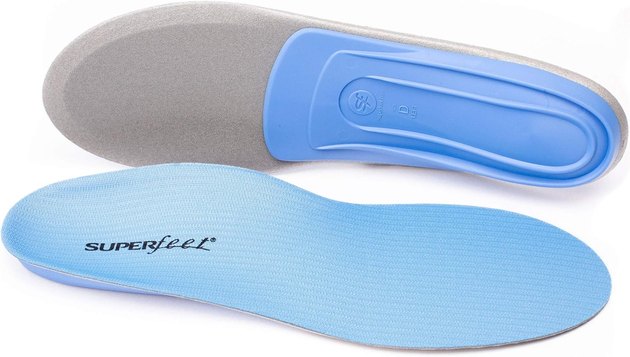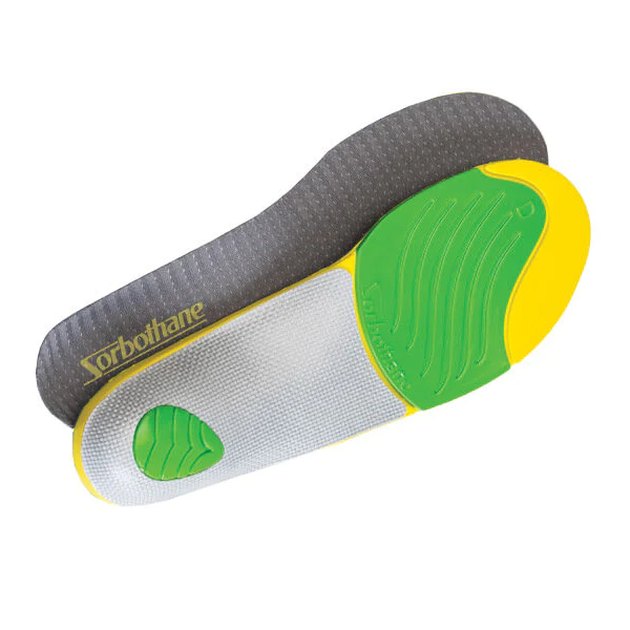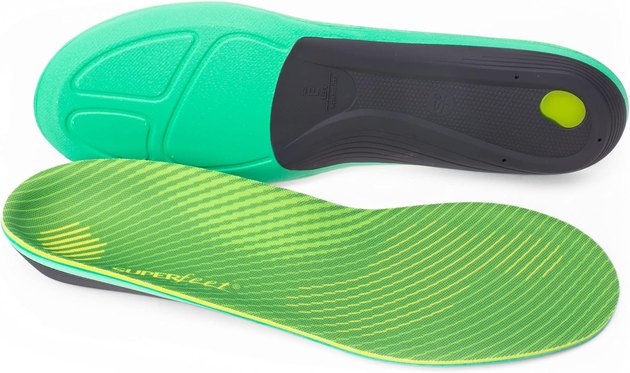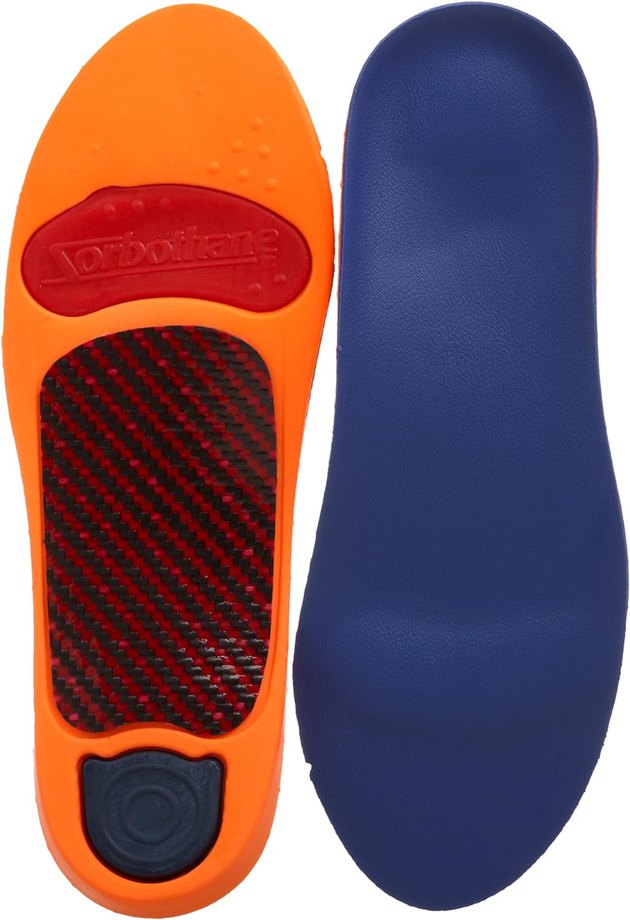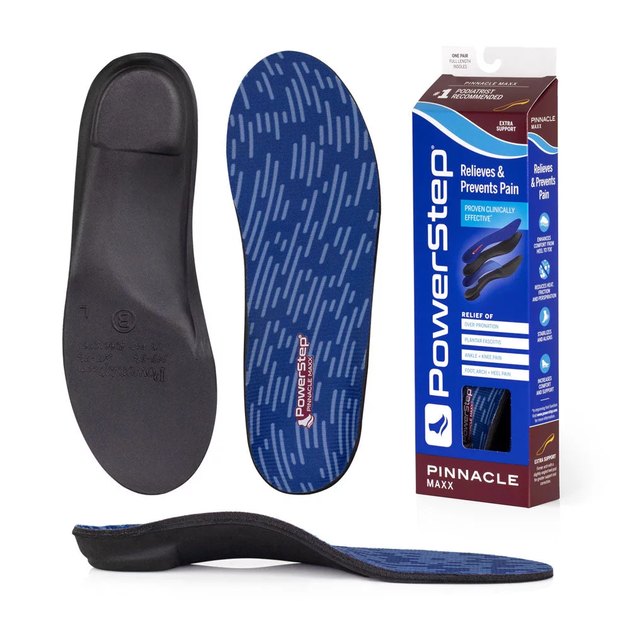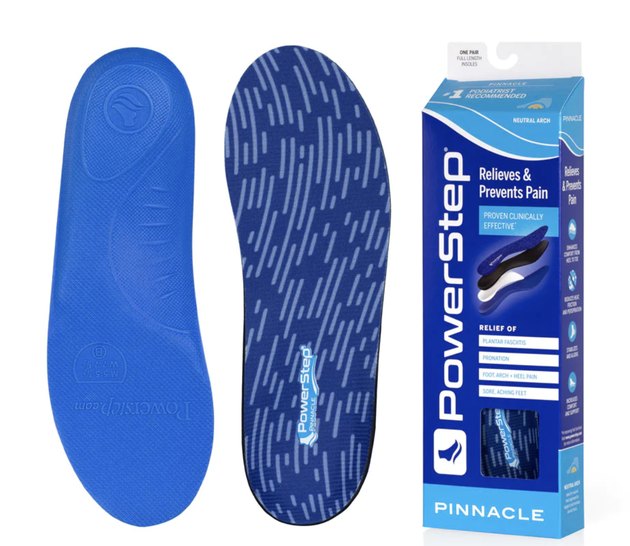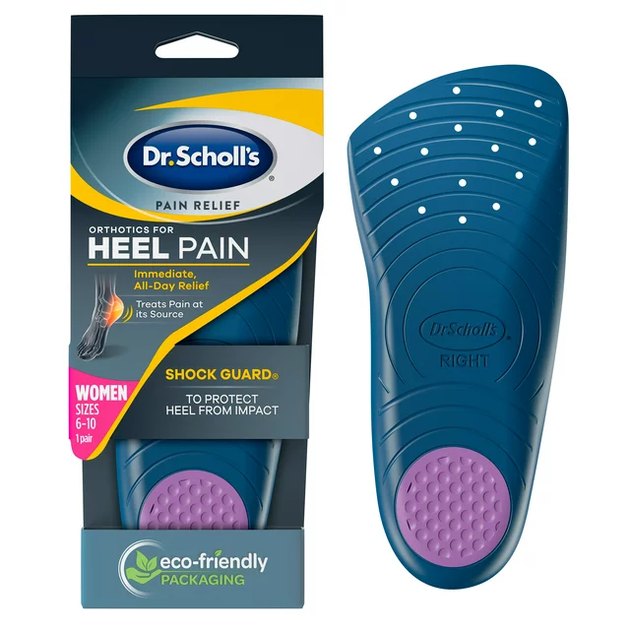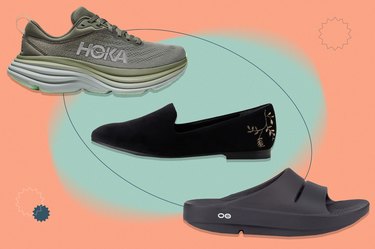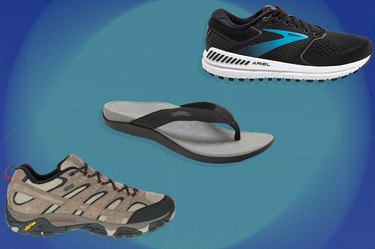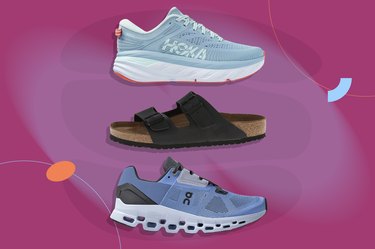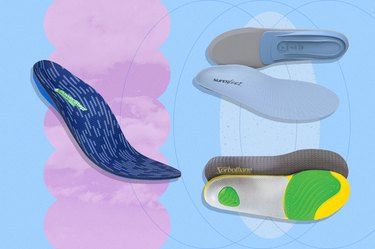
Shoe inserts offer relief for a variety of foot-related ailments, including pain due to plantar fasciitis, flat feet or just plain old uncomfortable shoes.
Shoe inserts are available over the counter at pharmacies, sporting goods stores and online, and you can find everything from gel inserts to custom foam insoles.
Video of the Day
Video of the Day
While shoe inserts are more affordable and accessible than prescription orthotics, they aren't tailored to the specific shape or condition of your feet.
Still, they can be an excellent step toward addressing foot pain.
The difficulty comes in knowing what type of shoe insert — of which there are very, very many — is best for you.
The Best Shoe Inserts
- Best Overall: Superfeet All-Purpose Support Medium Arch Insoles ($54.99, Superfeet)
- Best for Walking: Sorbothane Ultra PLUS Stability Insoles ($70.59, The Insole Store)
- Best for Running: Superfeet Run Support High-Arch Insoles ($54.99, Superfeet)
- Best for Standing All Day: Sorbothane Ultra Graphite Medium Arch Support Insoles ($57.99, The Insole Store)
- Best for Flat Feet: PowerStep Pinnacle Maxx ($52.95, PowerStep)
- Best for High Arches: PowerStep Pinnacle High ($49.95, PowerStep)
- Best for Plantar Fasciitis: Dr. Scholl's Heel Pain Relief Orthotic Inserts ($11.93, Amazon)
How We Chose
Through market research and with insight from podiatrists Kathryn Bosia, DPM, of West Virginia University Medicine Podiatry, and George Wallace, DPM, MBA, chair of the podiatry department at University Hospital in Newark, New Jersey, we've found the best shoe inserts available right now.
We used the following criteria:
- Material
- Support
- Function
- Cost
- Reviews
Find more info on how we choose and cover products here.
1. Superfeet All-Purpose Support Medium Arch Insoles
This consistently popular insole provides feet with moderate support that doesn't feel rigid and a firm cushion that doesn't feel too soft.
That balance between stability and comfort is what makes the Superfeet All-Purpose insole an excellent shoe insert for a wide variety of people who just want to upgrade their shoes — it shouldn't aggravate feet with high arches, and it won't leave flat feet feeling unsupported.
Designed for long-term wear and to reduce stress across the foot, the Superfeet All-Purpose insole is a dependable middle-of-the-road option for anyone looking to supplement their shoes with an insert.
Superfeet also offers insoles for different needs: If you're in search of the best arch support insoles for high heels, for example, the "insole finder" feature on the company's website can help you pick the right ones for you.
2. Sorbothane Ultra PLUS Stability Insoles
This insole brand, known for its shock-absorbing foam material, comes highly recommended by Dr. Wallace.
These inserts in particular not only offer maximum impact absorption but a highly stable structure, a deep heel cup and a moisture-wicking cover, too. Their design ensures that arches stay supported and the balls of the feet have ample, responsive cushion.
Whether you have a long day of errands or a stroll through the park ahead of you, Sorbothane's Ultra PLUS Stability Insoles will make extended periods of walking feel easy.
3. Superfeet Run Support High-Arch Insoles
Running-specific inserts need to be lightweight, supportive and designed to prevent foot fatigue. And, with the right pick, insoles can help your running, rather than slow you down.
The Superfeet Run Support insole checks all those boxes and more, featuring cushioning that runs its entire length, a heel cup specifically made to disperse impact and an odor-controlling top layer. Its construction helps prevent painful pressure points by springing back into shape in response to compression.
With these inserts from Superfeet, adding a layer of comfort to your favorite pair of running shoes doesn't have to mean sacrificing speed or performance. They may need a few wears to break in, according to customer reviews, but after that initial period they will have adjusted to your foot.
Could Running Insoles Help if Your Calves Burn?
Runners whose calves burn may turn to running insoles to help alleviate discomfort related to running.
What makes the right insert may be different for every runner.
Runners with high arches or flat feet may discover they have unbalanced pronation, which can lead to calf burning. Improper insoles for your foot type can also cause burning in your calves. Orthotic insoles can assist in correcting bad alignment by restraining foot pronation, according to the American Podiatric Medical Association.
Orthotics work to restore the natural foot and arch alignment during running . Proper foot positioning can alleviate calf burning and other lower extremity injuries associated with running.
There are some tried and true ways to break in new running shoes, so if your new shoes are causing you calf pain, make sure you're following the proper steps for getting comfortable in your sneaks.
Wearing the right shoe inserts for calf strain can help alleviate the pain. If you're finding that it's your running shoe inserts or the actual shoe that's causing calf pain, you should meet with a running shoe product expert to discuss possible options.
It is not recommended to craft any kind of DIY arch support insoles, but if you're interested, there are custom insoles available online.
4. Sorbothane Ultra Graphite Medium Arch Support Insoles
Standing for hours at a time calls for a durable shoe insert that won't compress and collapse with extended wear.
Sorbothane Ultra Graphite Medium Arch Support Insoles are made with this need in mind and feature a gel forefoot pad, a medium-height arch, a padded and contoured heel and an air-infused bottom layer.
These elements work in tandem to keep feet comfortable, dry and properly aligned throughout the day, while reducing the overall pressure and impact on wearers' feet.
Dr. Bosia also suggests investing in an anti-fatigue mat for additional support, especially if you have to stand on a hard, concrete floor all day.
5. PowerStep Pinnacle Maxx
If you have flat feet or fallen arches and experience foot pain as a result, look for an insert with a firm arch that will stabilize your feet without feeling too stiff, like PowerStep's Pinnacle Maxx insoles.
These inserts are as comfortable as they are supportive, with an angled heel that promotes a healthy range of motion while encouraging a lift in otherwise flat feet.
While they are on the firmer side, the Pinnacle Maxx insoles' design provides cushion where it's needed most, relieving the pain that can come with having flat feet.
(For the record, Dr. Wallace points out that some people may have flat feet and experience no pain at all, in which case they don't need an insert to the same degree that people with pain do.)
6. PowerStep Pinnacle High Insoles
Dr. Bosia notes that finding an over-the-counter shoe insert for high arches can be difficult — harder than for, say, people with flat feet.
But thanks to its deep heel cup, supportive high arch and overall cushioning, the PowerStep Pinnacle High insole is a great place to start.
These inserts don't merely act as a firm, stabilizing layer. They actually create a sense of depth across the sole of the foot, cradling the heel and rising at the midpoint to hold high arches in place. Feet should feel less strained and fatigued with continued use.
7. Dr. Scholl’s Heel Pain Relief Orthotic Inserts
Designed with plantar fasciitis and heel spurs in mind, this partial insert features a dense cushion in the heel cup, which provides maximum support while protecting the heel from impact.
This combination of structure and comfort helps reduce pain across the heel and absorb shock that occurs from walking and standing. The slight arch support also helps to absorb heavy impact on the heel, further relieving pressure and pain overall.
Dr. Scholl's Pain Relief Orthotics for Heel Pain are also an excellent option for anyone dealing with general heel pain.
What to Look for in a Shoe Insert
1. The Right Fit
At the risk of stating the obvious, you want to make sure your shoe insert will actually fit inside your shoes.
It should match your shoe size or be trimmable, and it shouldn't be so thick that it forces your foot out of the shoe when you try wearing it (and don't forget to remove the insole that came with your shoe before swapping in your new insert).
2. The Function You Need
In addition to physical fit, look for an insert that suits your activity level. Runners should seek out lighter-weight options, while people who stand all day should prioritize durability.
3. Comfort
Above all, even if you're shopping with a specific issue or condition in mind, don't let comfort fall too far down your list of priorities. Shoe inserts simply have to be comfortable, Dr. Wallace says. Otherwise, they won't be of much use.
What to Avoid in a Shoe Insert
1. A Shortened Length
Dr. Bosia generally discourages patients from buying inserts that aren't full-length.
A three-quarter length insert, for example, may make your foot feel uneven inside your shoe, leading to further discomfort. (An exception here is a heel cup for heel pain or plantar fasciitis, which Dr. Wallace recommends.)
2. Material That's Too Hard or Soft
In terms of materials, avoid anything that's too hard or too soft, Dr. Wallace says.
"You want something that's pliable, but not [one] where, when you put your foot in, it crushes down completely," he adds.
A shoe insert that is simultaneously supportive and cushioned can provide instant relief and sustained comfort in equal measure. Something that's stiff from the get-go won't be pleasant to wear at first, while a pair that your feet simply sink into will leave them feeling fatigued.
What Else You Should Know Before You Buy?
1. You May Have to Try a Few Before You Find the Best Fit
Dr. Bosia admits that finding the right shoe inserts requires some trial and error. Ideally, you can try the inserts on or at least feel them outside of their packaging before buying them.
But if you shop online or at a big box store, you might not have that option. So, there's always a possibility that you'll need to buy a few different pairs before finding one that clicks for you.
2. You May Not Notice Results Right Away
Dr. Wallace echoes this point, adding that it may take some time for your inserts to take effect once you start wearing them. For example, if you're using them to relieve discomfort from plantar fasciitis, wait a few months to see results. If you're still uncomfortable or haven't noticed any changes after that point, it's probably time to try something else or see a podiatrist for further recommendations and, potentially, a prescription insert.
3. Make Sure You're Wearing the Right Shoes First
Finally, Dr. Bosia and Dr. Wallace both emphasize the fact that your inserts are only as good as the shoes you put them in, so make sure you're starting with a pair of shoes that suit your feet and your activity level, and aren't actually exacerbating any pain or discomfort that you're hoping to address with an insole.
How to Put Insoles in Shoes
To ensure your insoles are doing their job, you'll want to make sure you're inserting them properly. It's also important to know how to remove insoles and best practices for replacing insoles in your boots, sneakers and everyday shoes.
Insoles will need to be replaced when they get worn, whether it's a basketball shoe insole replacement or a walking shoe replacement.
Step 1
Remove the old insole from each shoe. Insoles typically aren't glued to the bottom of a shoe, so they should come out easily. Use care to not rip the insole as you remove it.
In most cases, insoles will replace what comes with the shoe, so you'll need to remove what's first there. Unless the manufacturer advises otherwise, do not put your new insoles on top of the old ones.
Step 2
Bring the old insoles to use as a guide for a new pair when you purchase them. You can purchase new insoles based on the shoe size, but shoe sizes can vary slightly by brand and style of shoe.
Step 3
Research the kind of insole you want, based on how the shoes will be used or the level of cushioning desired.
Some insoles provide more cushioning at the heel for users who apply more weight to that area, while other types provide extra cushioning at the balls of the feet or the arch. Insoles also are available with various levels of flexibility, from highly flexible to very rigid.
Step 4
Slide the new insole into the shoe, toe first. Place your hand inside the shoe to adjust the insole so it is seated properly in the toe area. Push down on the insole's heel area so it is fully seated in the shoe.
Step 5
Trim the insoles if they do not sit properly in the toe or heel area. The new insole should sit flat against the bottom of the shoe. Use the old insole as a guide if trimming is necessary by placing it on top of the new insole and trimming excess areas.
Is this an emergency? If you are experiencing serious medical symptoms, please see the National Library of Medicine’s list of signs you need emergency medical attention or call 911.
